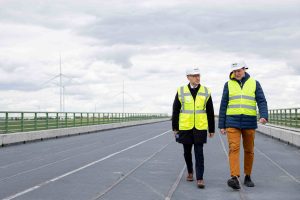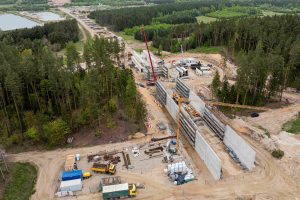Lithuanian Minister of Transport and Communications Eugenijus Sabutis, along with LTG Group CEO Egidijus Lazauskas, recently visited the Rail Baltica construction sites in the Jonava district. Here, five contractors from Lithuania and Italy are working on a 46.3 km section of the project. Notably, the first columns of what will become the longest railway bridge in the Baltic States have already been erected, with some reaching heights of up to 40 meters.
“Rail Baltica is a project of strategic importance for Lithuania and the entire Baltic region, and we are paying particular attention to its implementation. I encourage accelerating preparations for construction towards Poland and works from Kaunas to the Latvian border. Our focus must be on completing the first sections of this European rail corridor as soon as possible. This rail link is vital not only for convenient transport connections but also for national security,” says Lithuanian Minister of Transport and Communications, Eugenijus Sabutis.
“We are successfully meeting this year’s objectives: more than doubling the size of the Rail Baltica section under construction, preparing for the design of a crucial route to the Polish border, and making the necessary decisions. Rail Baltica is an international project with many stakeholders, requiring their active involvement, which is why we are pleased to be working closely with the Ministry of Transport and Communications,” says LTG Group CEO, Egidijus Lazauskas.
As the construction of the upper part of the bridge over the Neris progresses, preparations are underway for the concreting of the bridge superstructure, with the necessary equipment being delivered to Lithuania. This bridge is one of the most complex infrastructure projects in Lithuania’s history, not only due to its length (1.51 km) but also its height (40 meters). The superstructure employs three installation technologies, including moving scaffolding. It adheres to the highest environmental standards due to its location within the Natura 2000 network of protected areas. Additionally, the design ensures that there is no support within the River Neris.
In total, nearly 376 piles have been installed underground to support the superstructure. It is estimated that approximately 67,000 m³ of concrete and more than 11,000 tons of reinforcement will be needed for the 1.51 km bridge. In comparison, an average bridge in Lithuania typically requires around 2,000-5,000 m³ of concrete.
It is estimated that a high-speed train will cross the Neris Bridge in about 22 seconds. The Neris Bridge is scheduled for completion by the end of 2026, with one-third of the work currently completed.
The first 10 km section of the high-speed railway between Šveicarija and Žeimiai is scheduled for completion this year and will include over 40 different engineering structures, some of which are already operational. Track construction is also planned to commence on this section this year. Another 17.7 km section towards Šėta is expected to be completed early next year.
During the visit, representatives from the LTG Group and the Ministry of Transport and Communications discussed project priorities and met with contractors Fegda and Rizzani de Eccher. The Ministry intends to maintain ongoing meetings with other project contractors. LTG Infra has launched tenders for the contracting of new 68 km sections of embankment and civil engineering works. This year, work will be carried out on a total of 114 kilometers of railway sections.




